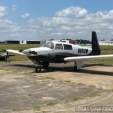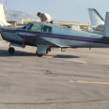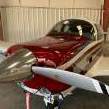-
Posts
1,640 -
Joined
-
Last visited
-
Days Won
5
MBDiagMan last won the day on May 14 2019
MBDiagMan had the most liked content!
Profile Information
-
Gender
Male
-
Location
NE Texas, KOSA
-
Interests
Flying, Hunting, Fishing, Music, Old Cars, Living in the peace and quiet 20 miles from the nearest four lane highway or railroad track.
-
Reg #
N9512M
-
Model
1967 M 20 F
Recent Profile Visitors
MBDiagMan's Achievements
-

CO2 detectors the "Good The Bad and The Ugly
MBDiagMan replied to Jpravi8tor's topic in Vintage Mooneys (pre-J models)
Thanks for the replies. After we flew it on Friday and discovered high levels in the back they sealed things up and said that there is an area , I think around the wire bundle that they want to make a sheet metal cover for, if necessary. We flew it this morning and found drastically lower CO levels, but still not acceptable. They have an EXCELLENT sheet metal man that is going to make a shield for the suspect area. I will continue to report results in an effort to help others in the future. -

CO2 detectors the "Good The Bad and The Ugly
MBDiagMan replied to Jpravi8tor's topic in Vintage Mooneys (pre-J models)
It seems that this thread has degenerated into a discussion of whether or not to mandate CO detectors. In spite of that fact, I feel that I should continue to post my findings on this problem in an effort to see that someone in the future is helped by it. we flew it this morning after trying to stop what appeared to be potential CO leaks. A mechanic flew with me with the detector able to move it around and we discovered that the concentration was much higher in the backseat area. What’s on the ground I went to the back of the baggage area and found a gap in the bottom of the very rear baggage compartment panel. They were going to seal up that area and I will fly again Monday. I believe there is a good chance that this is where the problem is. I believe that it is getting in the tail cone and then forcing past that area at the back of the baggage compartment. I will report back as we learn more. Thanks for your comments and suggestions. -

CO2 detectors the "Good The Bad and The Ugly
MBDiagMan replied to Jpravi8tor's topic in Vintage Mooneys (pre-J models)
A roll cage is not “required” on my off-road rock crawling Jeep either, but I beefed it up considerably. Especially since some of my grandkids are with me sometimes. -

CO2 detectors the "Good The Bad and The Ugly
MBDiagMan replied to Jpravi8tor's topic in Vintage Mooneys (pre-J models)
Thanks for the suggestion, but it has already confirmed with two separate detectors. I did that before I confirmed it as an issue. -

CO2 detectors the "Good The Bad and The Ugly
MBDiagMan replied to Jpravi8tor's topic in Vintage Mooneys (pre-J models)
Great thread! Recently had someone fly with me that had a CO detector in their headset and it was set off indicating high levels. I then bought a Sensorcon AV8 and am happy with it. What no one spoke of in this thread was the levels that they have measured inside the cockpit of their Mooneys and experiences with high levels and how you corrected it would be greatly appreciated. I was reading 440 ppm through a short flight and it was time for annual. They started trying to find the leak and gave the plane back to me and it’s now reading a little over 800.. They have blocked the heater and they have pressure tested the exhaust and heater system and are unable to explain the high-level. any experiences that you’ve had with high levels I would love to hear about as we are trying to get to the bottom of this. Thanks for any help you can offer. -
As I recall, I had just a little over 100 hours when I bought my first Mooney. At that point, virtually all of my time was tailwheel and the jump to the Mooney involved the wonderful instructor that ferried the plane to my home airport flying with me for a day. When it comes down to it, a Mooney is just another nose wheel airplane except you have to remember to put the wheels down. My initial insurance was only very slightly more expensive than my Cessna insurance. I think I had to have ten hours with a CFI and that was it. The rate stayed very affordable until I reached the age of 74 and then it tripled in one fell swoop. I think at your age it won’t be ridiculously expensive. Don't let anyone talk you out of a Mooney. There is no shortage of naysayers, most of which haven’t even been inside of one, but will tell that it’s cramped, hard to get into, expensive to maintain,……. In eight years of Mooney ownership, I have found none of those complaints to be true for me.
-

Looking to see if I fit in a m20c
MBDiagMan replied to Quantum Blueberry's topic in Vintage Mooneys (pre-J models)
As far as fitting into one goes, unless you are a very large person it is not as much about size as it is position. What I mean by that is that in a Mooney, your seating position is much like a sports car as opposed to a truck. Your legs are straight out in front of you and the panel is very close to you. If you are getting out of a 172 for example, you are accustomed to your feet below you, as if you’re sitting on a barstool and the panel far away from you. I have usually had a sports car around during my life and the seating in my Mooney is very familiar to me. For some this is a very unusual seating position. It is a matter of what you get used to. as far as insurance goes, when I bought my Mooney, I was 68. my insurance was very reasonable when I hit 73 after a year of less hours in the Mooney, insurance tripled. if you are young, I don’t think insurance will be crazy expensive although more expensive than an equal value 172. -

If you need/want the OEM 40:1 Gear Set
MBDiagMan replied to Matthew P's topic in Vintage Mooneys (pre-J models)
If I could read a projected price, I might be interested in a set. Have there been any guesses? -

Deciding when to reseal/bladder vs patch
MBDiagMan replied to Huckster79's topic in Vintage Mooneys (pre-J models)
Wow! $750 to $1750! Now there’s some inflation for you! -
When it comes to using the brakes, I find the Mooney brakes a little grabby compared to the Cleveland’s on my other plane. I have to be careful not lock up a wheel when in the Moony. Luckily I’m almost always on at least 6,000 feet in the Mooney so it’s not an issue unless I’m wanting to turn off the runway quickly. The next time I’m trying to make the next turnoff I will try to remember to deploy the brakes as I pull up the flaps.
-
I had understood from some reading long ago that they killed the lift on about 3 feet of the wing. Wish I remember where I read that. They do, however, obviously provide drag also or instead, or both.
-

Do You Use Speed Brakes for Anything Unusual?
MBDiagMan replied to MBDiagMan's topic in General Mooney Talk
Thanks Lance! -
When I first got serious about buying a Mooney, I called the instructor who taught me to fly in 1992. Not only a great instructor but a fellow tailwheel as well as a Mooney enthusiast having owned several over the years. When I started asking if I would be able to fly a Mooney he told me two things; “it will be great to get you out of a taildragger into something easier to fly” and “the only thing that will be difficult is learning to slow it down.” At that point I found an incredible C model, bought it, and “learned to slow it down.” A couple of years later, I tripped and hurt my shoulder which led me to turning loose of my beloved Manual Gear C. I then went into a beautiful electric gear F model with all exterior J updates except, of course, for the wing. It also had speed brakes. I used the speed brakes from the beginning for slowing it down to gear speed and then trading the speed brakes for gear at the initial approach fix and trimming nose up along the way for the descent. I learned to love the speed brakes. I flew it today for the first time in about eight weeks following some minor surgery. A pro pilot friend was with me and I got to fly and log an approach for the first time in a while. He liked the way I used the brakes, but the discussion reminded me of something said to me a long time ago about the speed brakes. I think it was Paul or Don Maxwell that made a comment about someone they knew used the speed brakes when landing. I didn’t ask any details at the time but my curiosity now arises. Has anyone ever used speed brakes when touching down? If so, did you deploy them when touching down? Retract them when touching down? Have you used them for anything else beyond simply slowing down to gear speed or dropping out of the sky quickly when too high? Curiosity killed the cat.
-

Deciding when to reseal/bladder vs patch
MBDiagMan replied to Huckster79's topic in Vintage Mooneys (pre-J models)
Maxwell repaired the tanks when I bought the plane 5 1/2 years ago and they were sealed well until some leaks appeared last summer. I left it at Dons for a week or so in the Summer and they repaired both tanks and they haven’t leaked a drop since. They did it for a fixed price of $750 per tank. I can live with $1500 every five years. I know there are no guarantees that it won’t end up being every year, but it also might go ten years. ”You pays your money and you takes your chances.” Flying isn’t cheap. -

Garmin 430 repair rumors - Finally finished??
MBDiagMan replied to Mark89114's topic in Avionics/Panel Discussion
The 430 is a great tool. I have one in both planes and they have both served me well. The aftermarket will keep them in service for a long time to come. Garmin has done a good job to support the family for as long as it has. Is there more up to date technology out there? Of course, but not everyone can afford eight or ten thousand bucks every time a new generation of technology comes along. Thanks Garmin!






